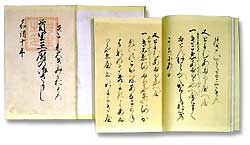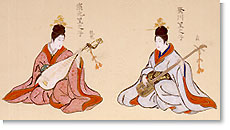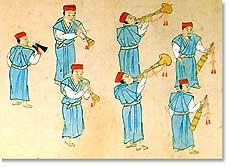
 |
|
| The establishment of Court music in the royal court of the Ryukyu Kingdom and in particular the appearance of Okinawa's classical music, raised the artistic level of Okinawan music to new heights. The Chinese style ceremonial and processional court music, the Uzagaku and Rojigaku music, imparts a real feeling of the immense breadth of Okinawa' s music. Since around the 16th century, the court music has soared in the winds of history. |
 "Omoro-soushi" |
Ryukyuan Classical Music -
It is said that it was the introduction of the Sanshin (samisen) from China, the start of the compilation of the Omoro-soushi ballads in the 16th century royal court, together with the creation of the 8-8-8-6 meter Ryuka songs that were the biggest factors in starting Okinawa's classical music. Especially essential for the emergence of Okinawa's classical music was the transmission of the Sanshin as an accompanying musical instrument. Evidence of this is shown by the fact that the authorities in classical music refer to the songs (uta) and the Sanshin (samisen) equally, by naming the genre "Uta-Sanshin". In the 17th century, talented performers who excelled in mainland Japanese performing arts compiled the Kun-Kun-Shi (musical scores) and while adding these kinds of innovations boldly cultivated the history of Okinawa's classical music. This has become the Okinawan classical music we have at present. Currently the performance qualities of the music are beginning to receive attention for their breadth of range, the way the intervals (Ma) are taken and the stresses in the music. There are three major schools in this type of music; Nomura-ryu, Afuso-ryu, and Tansui-ryu. The songs of Ryukyuan Classical music have been collected into the "Kun Kun Shi", a four volume compilation comprising 240 songs and two volumes of songs used in Ryukyuan Dance. These include "Kajadifu-bushi" (Song for a joyous occasion), Ju-shichi-hachi-bushi (Waiting at dusk), "Shukke-bushi" (The coming of dawn), "Nubuyi-Kuduchi" (Procession to Edo), and "Kuti-bushi." (Evergreens) |
|||||||
 Uzagaku |
Uzagaku -
The court music of the Ryukyu Kingdom era. This type of music was performed in Edo (Tokyo) during the obligatory visits made there and also for the entertainments for the Sappu investiture envoys from China. There were nineteen musical instruments used in the ensembles that performed this music including the Biwa (a four-stringed lute), the Erhu (a two-stringed fiddle), and the Shiko. Typical of these songs is the composition "Shidaikei". This genre of music expresses the elegance of the Ryukyuan royal court of old. The court music encompasses the Uzagaku genre. Because of the limited number of persons who could see this type of chamber music it was not conveyed to a large audience. After the dissolution of the Ryukyu Kingdom, it was not performed.
The Uzagaku Performance Research Association
|
|||||||
 Sappushi (Chinese Investiture Envoys) |
Rojigaku -
The term denotes a type of march or processional music originating in China. During ceremonies within Shurijo Castle and on occasions when the king would leave the castle, such as the processions to Edo (Tokyo), this type of music would be played with the Tsuona (a kind of charumella flute) and hand drums. This music has been designated an Intangible Ethnic Cultural Asset |
|||||||
| Photo : Okinawa Prefectural Museum, Melfirst Ltd. | ||||||||